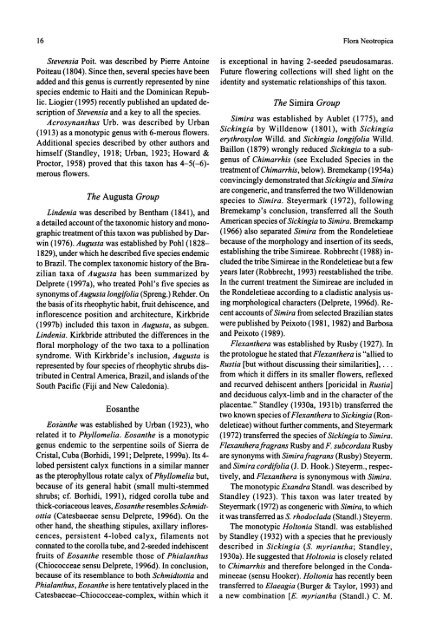Rondeletieae (Rubiaceae): Part I (Rustia, Tresanthera ... - CNCFlora
Rondeletieae (Rubiaceae): Part I (Rustia, Tresanthera ... - CNCFlora
Rondeletieae (Rubiaceae): Part I (Rustia, Tresanthera ... - CNCFlora
You also want an ePaper? Increase the reach of your titles
YUMPU automatically turns print PDFs into web optimized ePapers that Google loves.
16 Flora Neotropica<br />
Stevensia Poit. was described by Pierre Antoine is exceptional in having 2-seeded pseudosamaras.<br />
Poiteau (1804). Since then, several species have been Future flowering collections will shed light on the<br />
added and this genus is currently represented by nine identity and systematic relationships of this taxon.<br />
species endemic to Haiti and the Dominican Republic.<br />
Liogier (1995) recently published an updated de-<br />
The Simira Group<br />
scription of Stevensia and a key to all the species.<br />
Acrosynanthus Urb. was described by Urban<br />
Simira was established by Aublet (1775), and<br />
(1913) as a monotypic genus with 6-merous flowers. Sickingia by Willdenow (1801), with Sickingia<br />
Additional species described by other authors and erythroxylon Willd. and Sickingia longifolia Willd.<br />
himself (Standley, 1918; Urban, 1923; Howard &<br />
Baillon (1879) wrongly reduced Sickingia to a sub-<br />
Proctor, 1958) proved that this taxon has 4-5(-6)genus<br />
of Chimarrhis (see Excluded Species in the<br />
merous flowers.<br />
treatment of Chimarrhis, below). Bremekamp (1954a)<br />
convincingly demonstrated that Sickingia and Simira<br />
are congeneric, and transferred the two Willdenowian<br />
The Augusta Group<br />
species to Simira. Steyermark (1972), following<br />
Lindenia was described by Bentham (1841), and Bremekamp's conclusion, transferred all the South<br />
a detailed account of the taxonomic history and mono- American species of Sickingia to Simira. Bremekamp<br />
graphic treatment of this taxon was published by Dar- (1966) also separated Simira from the <strong>Rondeletieae</strong><br />
win (1976). Augusta was established by Pohl (1828- because of the morphology and insertion of its seeds,<br />
1829), under which he described five species endemic establishing the tribe Simireae. Robbrecht (1988) into<br />
Brazil. The complex taxonomic history of the Bra- cluded the tribe Simireae in the <strong>Rondeletieae</strong> but a few<br />
zilian taxa of Augusta has been summarized by years later (Robbrecht, 1993) reestablished the tribe.<br />
Delprete (1997a), who treated Pohl's five species as In the current treatment the Simireae are included in<br />
synonyms ofAugusta longifolia (Spreng.) Rehder. On the <strong>Rondeletieae</strong> according to a cladistic analysis usthe<br />
basis of its rheophytic habit, fruit dehiscence, and ing morphological characters (Delprete, 1996d). Reinflorescence<br />
position and architecture, Kirkbride cent accounts of Simira from selected Brazilian states<br />
(1997b) included this taxon in Augusta, as subgen. were published by Peixoto (1981, 1982) and Barbosa<br />
Lindenia. Kirkbride attributed the differences in the and Peixoto (1989).<br />
floral morphology of the two taxa to a pollination Flexanthera was established by Rusby (1927). In<br />
syndrome. With Kirkbride's inclusion, Augusta is the protologue he stated that Flexanthera is "allied to<br />
represented by four species of rheophytic shrubs dis- <strong>Rustia</strong> [but without discussing their similarities],...<br />
tributed in Central America, Brazil, and islands of the from which it differs in its smaller flowers, reflexed<br />
South Pacific (Fiji and New Caledonia).<br />
and recurved dehiscent anthers [poricidal in <strong>Rustia</strong>]<br />
and deciduous calyx-limb and in the character of the<br />
Eosanthe<br />
placentae." Standley (1930a, 1931b) transferred the<br />
two known species of Flexanthera to Sickingia (Ron-<br />
Eosanthe was established by Urban (1923), who deletieae) without further comments, and Steyermark<br />
related it to Phyllomelia. Eosanthe is a monotypic (1972) transferred the species of Sickingia to Simira.<br />
genus endemic to the serpentine soils of Sierra de Flexantherafragrans Rusby and F. subcordata Rusby<br />
Cristal, Cuba (Borhidi, 1991; Delprete, 1999a). Its 4- are synonyms with Simirafragrans (Rusby) Steyerm.<br />
lobed persistent calyx functions in a similar manner and Simira cordifolia (J. D. Hook.) Steyerm., respecas<br />
the pterophyllous rotate calyx of Phyllomelia but, tively, and Flexanthera is synonymous with Simira.<br />
because of its general habit (small multi-stemmed The monotypic Exandra Standl. was described by<br />
shrubs; cf. Borhidi, 1991), ridged corolla tube and Standley (1923). This taxon was later treated by<br />
thick-coriaceous leaves, Eosanthe resembles Schmidt- Steyermark (1972) as congeneric with Simira, to which<br />
ottia (Catesbaeeae sensu Delprete, 1996d). On the it was transferred as S. rhodoclada (Standl.) Steyerm.<br />
other hand, the sheathing stipules, axillary inflores- The monotypic Holtonia Standl. was established<br />
cences, persistent 4-lobed calyx, filaments not by Standley (1932) with a species that he previously<br />
connated to the corolla tube, and 2-seeded indehiscent described in Sickingia (S. myriantha; Standley,<br />
fruits of Eosanthe resemble those of Phialanthus 1930a). He suggested that Holtonia is closely related<br />
(Chiococceae sensu Delprete, 1996d). In conclusion, to Chimarrhis and therefore belonged in the Condabecause<br />
of its resemblance to both Schmidtottia and mineeae (sensu Hooker). Holtonia has recently been<br />
Phialanthus, Eosanthe is here tentatively placed in the transferred to Elaeagia (Burger & Taylor, 1993) and<br />
Catesbaeeae-Chiococceae-complex, within which it a new combination [E. myriantha (Standl.) C. M.
















